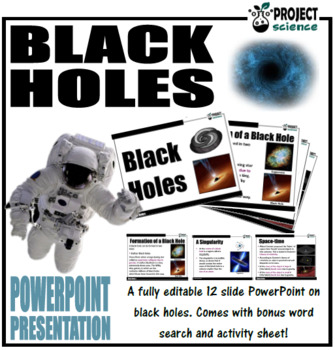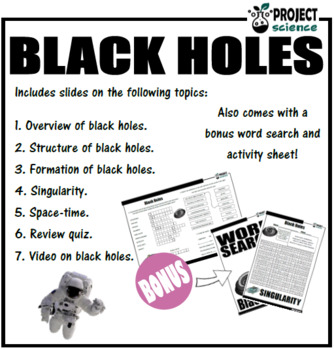Black Holes PowerPoint and Activity Sheets
PROJECT science
498 Followers
What educators are saying
Was in a bind and did not want to reinvent the wheel. Thank you for the lesson, would definitely recommend.
Loved using this engaging activity for my high school astronomy course! Would highly recommend for any high school astronomy teacher!
Description
A fully editable 12 slide PowerPoint presentation on the structure and formation of black holes. Includes slides on the following topics:
➸ Overview black holes
➸ Formation of black holes
➸ Structure of black holes
➸ Singularity
➸ Spinning black holes
➸ Space-time
➸ Review quiz with answers
➸ Embedded video on black holes
Comes with a bonus black holes activity sheet as well as a word search with solutions on key terminology.
If you would like notifications on free and new resources as well as upcoming sales be sure to follow my TpT store by clicking the 'Follow Me' link above.
Clipart by:
Total Pages
Answer Key
N/A
Teaching Duration
N/A
Last updated Apr 18th, 2020
Report this resource to TPT
Reported resources will be reviewed by our team. Report this resource to let us know if this resource violates TPT’s content guidelines.
Standards
to see state-specific standards (only available in the US).
CCSSRST.6-8.4
Determine the meaning of symbols, key terms, and other domain-specific words and phrases as they are used in a specific scientific or technical context relevant to grades 6–8 texts and topics.
NGSSMS-ESS1-3
Analyze and interpret data to determine scale properties of objects in the solar system. Emphasis is on the analysis of data from Earth-based instruments, space-based telescopes, and spacecraft to determine similarities and differences among solar system objects. Examples of scale properties include the sizes of an object’s layers (such as crust and atmosphere), surface features (such as volcanoes), and orbital radius. Examples of data include statistical information, drawings and photographs, and models. Assessment does not include recalling facts about properties of the planets and other solar system bodies.




